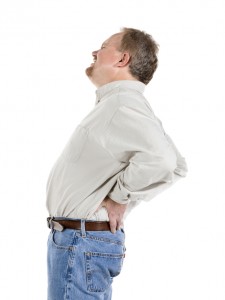
Old man with aching back
Low level laser therapy was first used in 1967 and is today gaining mainstream acceptance. When Endre Mester investigated the effects of laser on skin cancer, he probably no idea of the extent to which it would be used as an alternative to traditional medicine. Mester opened the door for other medical professionals and researchers to discover the benefits of low level laser treatment, or LLLT.
During the procedure, a red and near infra-red light is applied over the injured area to accelerate wound healing and provide relief for acute and chronic pain. The medical industry has embraced LLLT as a viable solution for the treatment of muscle pain. Indeed, it has succeeded in providing relief in cases where the use of pain killers and massage therapy has failed.
Following are some ways low level laser treatments help relieve muscle pain.
Neck and Shoulder Pain
Shoulder and neck pain are common conditions faced by millions of people worldwide. Based on the results of clinical trials, LLLT strengthens muscles and increases range of motion thereby reducing pain for patients suffering from the chronic pain caused by muscle spasms, thoracic spine strain, and osteoarthritis.
Muscle Pain After Surgery
Patients who undergo liposuction surgery often experience pain for a few weeks after the procedure. Surgeons today use LLLT immediately after the treatment to reduce the after-surgery pain and promote nerve regeneration after the procedure.
Carpel Tunnel Syndrome
Although still in the experimental phase, researchers are hopeful that LLLT can be used successfully to provide relief for people who suffer from carpel tunnel syndrome. The low level laser will be applied directly to the wrist area to relieve pain.
Lower Back Pain
Lower back pain is a common complaint, and although traditional medicine offers several treatment options, none of them are as effective as the application of LLLT to the affected area. Two 10-minute treatments a week have been proven to reduce the discomfort, pain, and immobility associated with lower back injuries.
